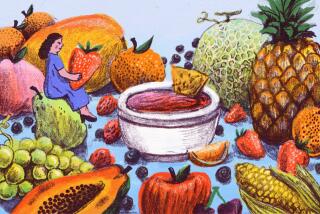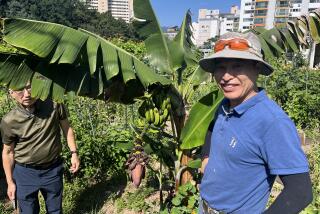The Mango Kings
- Share via
It’s mango season in South Florida. From June through September, these tropical, handsome fruits bejewel the back-yard groves and orchards there. Fruit stands spring up along roadsides, selling softball-size mangoes for as little as two for $1. At the height of the season, this luxurious fruit is so abundant that I cut mangoes into my breakfast cereal, whir them into milkshakes and generally pig out on a fruit that has become for me the saving grace of the steamy Floridian summer. In California, mango lovers must search out the fruit in grocery stores and farmers markets, but they are abundant now.
Novelist Tom Robbins has likened mango to a “ripe peach doused with kerosene.” The first part of his description is accurate: A ripe mango does have a peachy fragrance and sweetness. The sweetness is balanced by a musky tartness that some people compare to pineapple.
And many mango varieties (especially the Asian ones) do, indeed, have a kerosene or turpentine aftertaste. This quality is highly prized, for instance, in India, where mangoes are so popular that up to 1,000 varieties are grown.
To Floridians, mango means one of a half dozen varieties, all of them sweet, fruity and intensely flavored. The most famous is the large, round, sweet Hayden mango, named for Capt. John J. Hayden, who first planted them in Coconut Grove in 1902. The most popular commercial mango is the Tommy Atkins, a big, oval, bright red fruit with a fine flavor but sometimes fibrous flesh.
Extensive plantings in the Caribbean and Central and South America mean mangoes are available virtually year round, but to my mind, nothing beats a Florida mango at the height of the season. Thanks to varying ripening times, mango lovers can enjoy Florida mangoes from the end of May through September.
Early ripeners include the Tommy Atkins and the Florigan. Mid-June brings a red, medium-size, peach-flavored mango called the Van Dyke. July ushers in my personal favorite, a large, red-skinned, lusciously tart and virtually fiber-free mango called the Kent. Another mid-summer treat is the Palmer, an elongated, S-shaped mango with yellowish flesh and a flavor that hints at papaya. August brings a huge, oval, pink- or orange-tinged, sweet, mild-tasting mango called Keitt, which will carry into September.
When buying mangoes, look for unblemished fruits free of shriveled skin or soft spots. Mangoes are usually picked green and will ripen if left at room temperature (so don’t put unripe mangos in the refrigerator). Ripen them in a sealed paper bag.
When a mango is ripe, it will smell very fragrant and be squeezably soft. Contrary to popular belief, a red or orange skin isn’t the only sign of ripeness. Florigans and Palmers, for example, stay green even when ripe. Once mangos are ripe, they can be stored in the refrigerator. Diced or pureed mango can be frozen.
Eating mangoes can be a messy proposition. Indeed, here in Florida we say there’s only one way to eat a ripe mango: naked in the bathtub. Actually, there are two ways to separate the fruit from the flat, elongated seed. The first way is to peel the skin off with a sharp paring knife, then cut the flesh off the seed.
The second way is the “hedgehog” method, so called because it produces diamond-shaped spikes of mango that stick out like the spines of a hedgehog. Slice the top and bottom halves off the fruit, getting as close to the flat seed as possible. Using a sharp knife, cut a cross-hatch or tick-tack-toe pattern in the flesh down to the skin, but not cutting through it.
Now, holding the edges in your hands, press the skin with your thumbs to turn the slice inside out. Bite-size chunks of fruit will extend from the skin, ready to be scooped up with a spoon. Cut off any flesh that remains on the seed with a knife.
Not only do mangoes taste good, they’re good for you, being rich in potassium and in vitamins A and C. A medium mango contains about 135 calories and will serve two. A one-pound mango yields about 1 1/2 cups diced fruit or one cup mango puree.
To make mango nectar, cut the flesh off a couple of ripe mangoes (this is a good way to use up bruised or fibrous mangoes) and place in a blender with an equal volume of water and a little sugar and fresh lime juice. Puree until smooth and strain.
One of my favorite ways to use mangoes this time of year is in salsa. So fire up the barbecue grill and give the following recipe a try.
*
This colorful salsa combines two of South Florida’s favorite foods: mango and black beans. It makes a great accompaniment to roast chicken, grilled seafood or pork. It’s also good served as a salad or with chips as an appetizer.
MANGO AND BLACK BEAN SALSA
2 ripe mangoes
1 cup cooked black beans
4 green onions, finely chopped
1/2 Scotch bonnet chile or to taste, or 1 to 2 jalapeno chiles, minced and seeded, or for spicier salsa, leave seeds in
2 teaspoons minced ginger root
1/4 cup chopped cilantro or mint
3 to 4 tablespoons lime juice or to taste
1 1/2 tablespoons extra-virgin olive oil
1 tablespoon brown sugar, packed, optional
Salt
Freshly ground pepper, optional
Peel mangoes and cut flesh off seeds. Cut mangoes into 1/2-inch dice to make about 3 cups. Place in bowl along with black beans, green onions, chile, ginger root and cilantro.
Toss gently to mix. Add lime juice, olive oil and brown sugar. Season to taste with salt and pepper. Serve at once. Makes 4 servings.
More to Read
Sign up for The Wild
We’ll help you find the best places to hike, bike and run, as well as the perfect silent spots for meditation and yoga.
You may occasionally receive promotional content from the Los Angeles Times.






